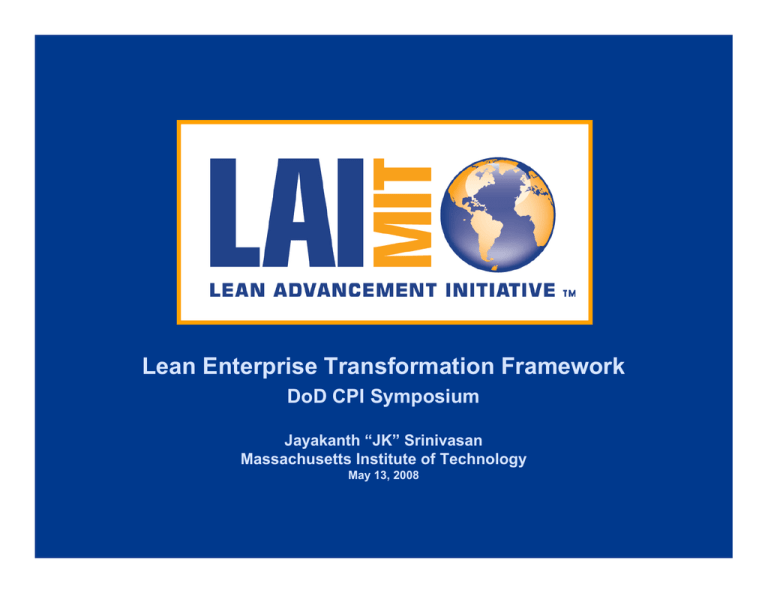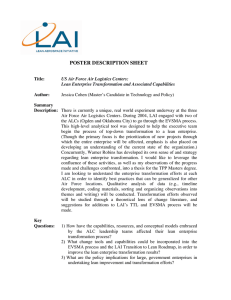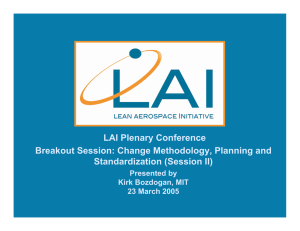Lean Enterprise Transformation Framework DoD CPI Symposium Jayakanth “JK” Srinivasan
advertisement

Lean Enterprise Transformation Framework DoD CPI Symposium Jayakanth “JK” Srinivasan Massachusetts Institute of Technology May 13, 2008 Creating a Holistic Approach to Enterprise Transformation Implementation Issue How do I motivate and sustain enterprise transformation? How do I transform my enterprise to lean? What analytical tools can I use to support my decision making? http://lean.mit.edu Enterprise Tool 7 Principles of Lean Enterprise Thinking Enterprise Transformation Roadmap Enterprise Architecting Framework Enterprise Strategic Analysis and Transformation (ESAT) © 2008 Massachusetts Institute of Technology J. Srinivasan 05/13/08- 2 7 Principles of Lean Enterprise Thinking 1. 2. 3. Adopt a holistic approach to enterprise transformation. Identify relevant stakeholders and determine their value propositions. Focus on enterprise effectiveness before efficiency. 4. 5. 6. 7. Address internal and external enterprise interdependencies. Ensure stability and flow within and across the enterprise. Cultivate leadership to support and drive enterprise behaviors. Emphasize organizational learning. Source: Nightingale and Srinivasan, MIT 2008 http://lean.mit.edu © 2008 Massachusetts Institute of Technology J. Srinivasan 05/13/08- 3 Lean Enterprise Transformation Roadmap STRATEGIC CYCLE Determine • Articulate Business Case for Lean Strategic • Focus on Stakeholder Value Imperative • Leverage Lean Gains Pursue & Sustain Enterprise Transformation Transformation Council Strategic Implications of Transformation… • Monitor & Measure the Outcomes • Nurture Process, & Imbed Nurture, Process & Imbed Lean Culture • Capture & Diffuse Lessons Lean Enterprise Learned Thinking • Synchronize Strategic Long-Term & Short-Term Cycles • Convey Urgency Engage • Foster Executive Lean Learning Leadership in • Obtain Executive Buy-In Transformation • Establish Executive Lean Long-Term Corrective Action PLANNING CYCLE A Committed Leadership Team Understand Current State • Perform Stakeholders Analysis • Define As-Is Value Stream • Perform Enterprise Assessment Implementation Results Implement & Coordinate Transformation Plan • Develop Detailed Project Implementation Plans • Synchronize Detailed Plans • Implement Projects and Track Progress • Commit Resources • Provide Education & Training Capabilities & Deficiencies Identified Short-Term Corrective Action Envision & Design Future Enterprise • Create Vision of Future State • Define “To-Be” Enterprise Value Stream • Perform Gap Analysis EXECUTION CYCLE Lean Enterprise Vision Create Transformation Plan • • • • Identify Key Enterprise Improvement Project Areas Determine Impact Upon Enterprise Performance Prioritize, Select and Sequence Project Areas Publish Communication Plan http://lean.mit.edu Alignment Requirements Identified… Source: Nightingale, Srinivasan and Mize, MIT 2008 Align Enterprise Infrastructure • • • • • Align Organization Align Incentives Empower Change Agents Rationalize Systems & Policies Align Metrics © 2008 Massachusetts Institute of Technology J. Srinivasan 5/13/08 Enabling Enterprise-Level Capability Strategy Goals, Vision, …, Business Model Doctrine First Principles; Overarching Organization More than an Org Chart – Culture; Behaviors, Clear Roles and Responsibilities Training Individual to Organizational; Developing Process Capability through Constructive Task Proficiency and Execution – Outcome is a Learning (Enterprise) Organization Material Product/Service Development for Success throughout the Lifecycle Leadership Situational Awareness → Decision Processes → Command and Coordination; Tacit and Implicit Knowledge Personnel with others Knowledge and awareness drive actions and create Facilities Deliberate inclusion in EA for Infra/Info-Structure prevents Islands of Excellence; creates Neighborhoods of Success synergy Source: Nightingale and Matty, March 04 Army Brief http://lean.mit.edu © 2008 Massachusetts Institute of Technology J. Srinivasan 05/13/08- 5 Enterprise Architecting – Enables Greater Efficiency and Effectiveness Strategy Organization Information • Effective integration – managing complex interdependencies • System optimization, not local optimization • Knowledge-based enterprise capabilities • Achieving desired future state characteristics Policy Enterprise Architecting Processes Products Knowledge Services http://lean.mit.edu • • • Agility Flexibility Reconfigurability © 2008 Massachusetts Institute of Technology J. Srinivasan 05/13/08- 6 Source: Nightingale and Rhodes, 2007 Enterprise Strategic Analysis and Transformation Strategic Objectives ESAT Enterprise Analysis Enterprise Identification Future State Vision Actionable Transformation Plan http://lean.mit.edu Source: Srinivasan, Bryant and Nightingale, 2008 © 2008 Massachusetts Institute of Technology J. Srinivasan 05/13/08- 7 Enterprise “To-Be” X-Matrix Source: L. Cropsey, “Integrating Military Unmanned Aircraft into the National Airspace System: An Application of Value-Focused Thinking and Enterprise Architecting”, MIT SDM Thesis, 2008 http://lean.mit.edu © 2008 Massachusetts Institute of Technology J. Srinivasan 05/13/08Slide8 8 6. Establish Options for Extension/Integr ation with Army Aviation & Determine • STRATEGIC Maintenance Lean Enterprise Transformation Roadmap 7. Determine Future Milestones Pursue & & Continuously Sustain Articulate Business Case for Lean Enterprise Improve Focus on Stakeholder Value Strategic • Imperative • Leverage Lean Gains CYCLE 5. Balance Government Oversight/Know Strategic Implications of Transformation ledge with Contract • Monitor & Measure the Outcomes Nurture, Efficiencies• Nurture, Process, & Imbed Process & Imbed Lean Culture • Capture & Diffuse Lessons Lean Enterprise Learned Thinking • Synchronize Strategic Long-Term & Short-Term Cycles Transformation • 1a. Establish a Governance Convey Urgency Foster ExecutiveStructure Lean Learning Engage • Leadership in • Obtain Executive Buy-In Transformation • Establish Executive Lean Transformation Council Long-Term Corrective Action 1b. Value Stream PLANNING CYCLE Identification A Committed Leadership Team Understand Current State 4. LSS Deployment • Perform Stakeholders Analysis • Define As-Is Value Stream 1bi. Assessment Determine • Perform Enterprise Process Interactions Implementation Results • Develop Detailed Project 3. Contract Implementation Plans Implement & Negotiation for • Synchronize Detailed Plans Coordinate • Implement Projects and Flexability/Scalability Transformation /AdaptabilityTrack Progress Plan • Commit Resources • Provide Education & Training Capabilities & Deficiencies Identified Short-Term Corrective Action Envision & Design Future Enterprise • • 1bii. Product/Service Create Vision of Future State Portfolio Define “To-Be” Enterprise Value Stream • Perform Gap Analysis 1biii. AFROGEN EXECUTION CYCLE 2. E-Log Book & Schedule Create Transformation Plan Development • • • • Identify Key Enterprise Improvement Project Areas Determine Impact Upon Enterprise Performance Prioritize, Select and Sequence Project Areas Publish Communication Plan Lean Enterprise Vision Alignment Requirements Identified http://lean.mit.edu http://lean.mit.edu Align Enterprise Infrastructure • • • • • Align Organization Align Incentives 1biV.Agents High-Level Empower Change Rationalize SystemsMetrics & Policies Align Metrics © 2008 Massachusetts Institute of Technology J. Srinivasan 05/13/08- 9 Source: Nightingale, Srinivasan and Mize © 2008 Massachusetts Institute of Technology D. Nightingale - MM/DD/YY- 9 Takeaway • Enterprise transformation is a journey that is • Driven both top-down and bottom-up • Enabled by a thorough understanding of the enterprise’s process architecture, measurement systems, and capabilities • Focused on stakeholder-centric value delivery • Guided by the 7 principles of lean enterprise thinking • Sustained through continuous enterprise architecting http://lean.mit.edu © 2008 Massachusetts Institute of Technology J. Srinivasan 05/13/08- 10




